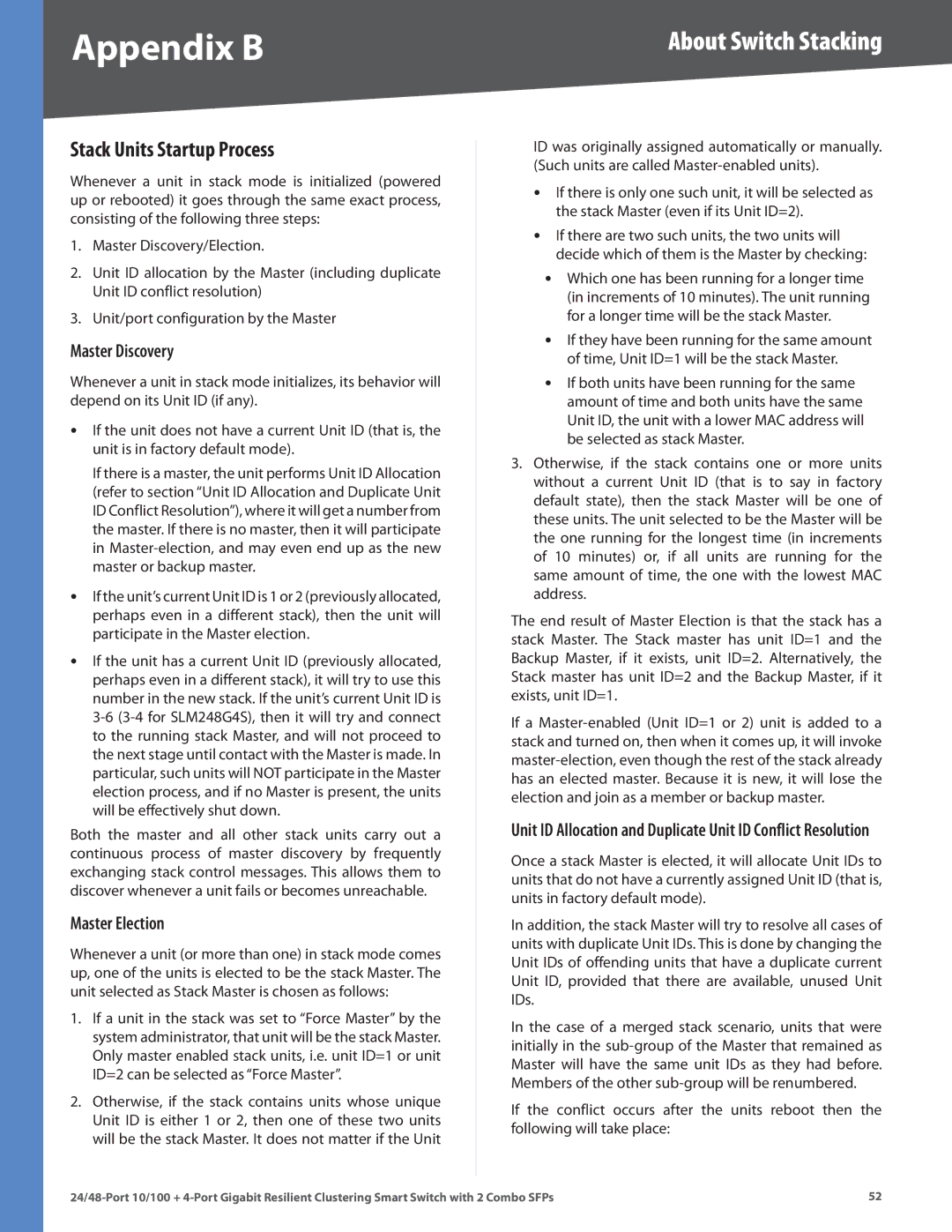
Appendix B | About Switch Stacking |
Stack Units Startup Process
Whenever a unit in stack mode is initialized (powered up or rebooted) it goes through the same exact process, consisting of the following three steps:
1.Master Discovery/Election.
2.Unit ID allocation by the Master (including duplicate Unit ID conflict resolution)
3.Unit/port configuration by the Master
Master Discovery
Whenever a unit in stack mode initializes, its behavior will depend on its Unit ID (if any).
•If the unit does not have a current Unit ID (that is, the unit is in factory default mode).
If there is a master, the unit performs Unit ID Allocation (refer to section “Unit ID Allocation and Duplicate Unit ID Conflict Resolution”), where it will get a number from the master. If there is no master, then it will participate in
•If the unit’s current Unit ID is 1 or 2 (previously allocated, perhaps even in a different stack), then the unit will participate in the Master election.
•If the unit has a current Unit ID (previously allocated, perhaps even in a different stack), it will try to use this number in the new stack. If the unit’s current Unit ID is
Both the master and all other stack units carry out a continuous process of master discovery by frequently exchanging stack control messages. This allows them to discover whenever a unit fails or becomes unreachable.
Master Election
Whenever a unit (or more than one) in stack mode comes up, one of the units is elected to be the stack Master. The unit selected as Stack Master is chosen as follows:
1.If a unit in the stack was set to “Force Master” by the system administrator, that unit will be the stack Master. Only master enabled stack units, i.e. unit ID=1 or unit ID=2 can be selected as “Force Master”.
2.Otherwise, if the stack contains units whose unique Unit ID is either 1 or 2, then one of these two units will be the stack Master. It does not matter if the Unit
ID was originally assigned automatically or manually. (Such units are called
•If there is only one such unit, it will be selected as the stack Master (even if its Unit ID=2).
•If there are two such units, the two units will decide which of them is the Master by checking:
•Which one has been running for a longer time (in increments of 10 minutes). The unit running for a longer time will be the stack Master.
•If they have been running for the same amount of time, Unit ID=1 will be the stack Master.
•If both units have been running for the same amount of time and both units have the same Unit ID, the unit with a lower MAC address will be selected as stack Master.
3.Otherwise, if the stack contains one or more units without a current Unit ID (that is to say in factory default state), then the stack Master will be one of these units. The unit selected to be the Master will be the one running for the longest time (in increments of 10 minutes) or, if all units are running for the same amount of time, the one with the lowest MAC address.
The end result of Master Election is that the stack has a stack Master. The Stack master has unit ID=1 and the Backup Master, if it exists, unit ID=2. Alternatively, the Stack master has unit ID=2 and the Backup Master, if it exists, unit ID=1.
If a
Unit ID Allocation and Duplicate Unit ID Conflict Resolution
Once a stack Master is elected, it will allocate Unit IDs to units that do not have a currently assigned Unit ID (that is, units in factory default mode).
In addition, the stack Master will try to resolve all cases of units with duplicate Unit IDs. This is done by changing the Unit IDs of offending units that have a duplicate current Unit ID, provided that there are available, unused Unit IDs.
In the case of a merged stack scenario, units that were initially in the
If the conflict occurs after the units reboot then the following will take place:
52 |
